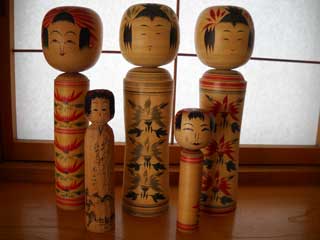Kokeshi (simple wooden dolls)
![]()
If you plan to visit Japan and look for a good souvenir, there is a good one; kokeshi. Kokeshi are simple wooden dolls unique to Japan. The dolls have a round head and cylindrical body and their hair, face and kimono are painted on but they do not have arms or legs. Any souvenir store throughout Japan carries kokeshi dolls but they originated in Tohoku, the north part of Honshu in Japan.
Around the end of the Edo period, nearly 200 years ago, the custom of hot spring cure came to spread among peasants in the region. They went to hot spring resorts deep in the mountains. The local woodcraftsmen turned the lathe and made simple dolls for the visitors. Peasants bought the dolls for their children, especially for girls.
Traditional kokeshi dolls are still produced in the Tohoku region but today, creative kokeshi dolls are made and their number is increasing and sold in many areas in Japan. Traditional kokeshi dolls represent girls and they are made of dogwood or maple trees while creative ones have various kinds of figure, face and cloth. Some are modeled on animals, Santa Clause, monsters and so on. The material can sometimes be zelkova or chestnut trees. Although traditional and creative kokeshi dolls are different in many points, there is one thing in common. Kokeshi dolls do not have arms or legs.
Then, why do kokeshi dolls not have limbs? As far as I know, there are two reasons. One story says that kokeshi dolls had limbs at the beginning of their history. Woodcrafters carved the arms and legs on the body. Later, the carving was replaced by painting then the limbs were hidden by the patterns of kimono, so kokeshi dolls do have arms and legs, it's just that they are invisible. The other story has a religious aspect. It is said that the figure of kokeshi dolls represents the magic wand so that the dolls can work as a lucky charm to protect children. When children grow up, the dolls are said to have completed their role and are consequently burned and sent back to the mountains.

